Patriot Pyro SE 240 GB Solid State Drive Review

Let’s get acquainted with one more SSD based on second generation SandForce platform.
In our latest articles we discussed solid state drives based on Indilinx Everest or Marvell 88SS9174 controllers. Unlike SandForce SF-2281, these two controller chips are not as popular: they are used in individual products with very unconventional characteristics. Of course, it creates increased interest in such SSDs, but their variety is pretty limited. Therefore, we are forced to get back to reviewing much more widely spread products on SandForce controllers. And today we are proud to present to you another member of the family – Patriot Pyro SE.
Almost all the manufacturers of memory modules for computer enthusiasts are now trying to join the ranks of the solid state drive makers. Some of them, like OCZ, Kingston or Corsair manage to become the leaders in this promising market segment. Patriot seems to be more of a new mainstream SSD maker. They currently offer only products built on SandForce controllers, do not have a very large variety and in terms of time to the market Patriot is quite a bit behind the leaders here.
Nevertheless, when it comes to SandForce platform, the production volumes and brand recognition do not really matter too much. It is the controller developer who designs PCBs and firmware that is why all SandForce SF-2281 based SSDs are of almost the same quality and perform at practically identical speeds. The differences are mostly in the warranty terms, but this is something you can’t complain about with Patriot. This is a respectful well-known manufacturer with great reputation. Therefore if you are considering buying a SandForce based drive, then you should totally check out Patriot products alongside with the offerings from OCZ, Kingston or Corsair. Especially since in many cases Patriot offers a much more attractive price point. Therefore, when we received a 240 GB Patriot Pyro SE, we decided to dedicate a separate individual review to this product.
Closer Look at Patriot Pyro SE 240 GB
We have already reviewed patriot solid state drives on SandForce SF-2281 controller from Wildlife and Pyro series. The first SSD that belongs to Patriot’s flagship solutions used flash memory with Toggle Mode interface. The second drive, a low-cost one, was built with asynchronous memory. So, to complete the line-up we needed to take a closer look on the third modification with intermediate price and performance, built with synchronous flash memory using ONFI interface. This is exactly what Patriot Pyro SE is and frankly speaking, we are not quite sure why it came into the market so much later than the first two models. Moreover, products like that, perfectly balanced in terms of price and performance, are usually the most popular ones.
Patriot Pyro SE ships in a small cardboard box designed in black and brick-red colors.
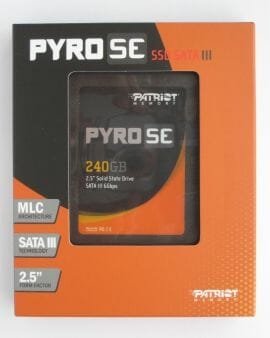
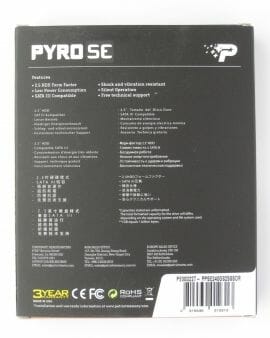
Inside the box we find the SSD sealed in clear plastic blister and a sheet with user instructions. Note that the manufacturer didn’t include any retention rails for the 3.5-inch system case bay. Therefore, in some cases additional investment into an appropriate retention kit may be required. In other words, I it fair to conclude that there are practically no accessories bundled with this SSD.
The exterior design of this solid state drive is pretty straight-forward. Patriot Pyro SE case is designed in a traditional SSD form-factor of 2.5 inches and is made of thick silumin-like alloy. There are stickers on both sides of the SSD: a sticker with the marketing info on one sides, and a sticker with the product part number, bar codes, certification logos and “Assembled in the USA” not on the other.
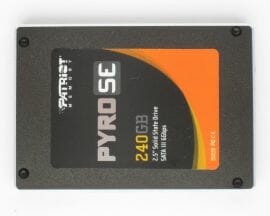
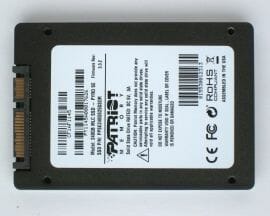
Inside this not your typical case, which, by the way, is manufactured for Patriot by Akust Company, there is a common PCB with a second-generation SandForce SF-2281 controller. It is pretty funny that Patriot engineers decided to add some extra support for this PCB inside the SSD case by sticking it on top of a small gummy cake.
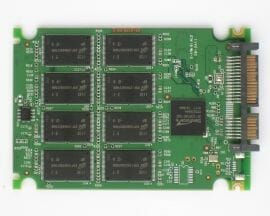
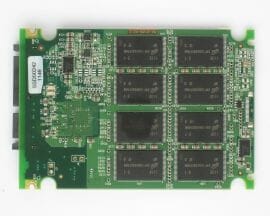
The flash memory in Patriot Pyro SE is manufactured by Micron. There are sixteen chips marked as 29F128G08CFAAB, which are quite often used in contemporary solid state drives. Each of these chips is 128 Gbit large and consist of two 64 Gbit semiconductor dies stacked one on top of the other. As a result, the drive we are discussing in this review has 32 NAND devices connected to an eight-channel controller with 4-way interleaving. Since they use memory with synchronous ONFI 2.2 interface with 133MB/s data transfer rate, we can conclude that the hardware configuration of Patriot Pyro SE is fully identical to that of such popular models as OCZ Vertex 3, Kingston HyperX SSD or Corsair Force GT.
The firmware of Patriot Pyro SE is also quite common: it is typical SandForce firmware. The current version is 3.3.2 and it is finally the version where the SandForce SF-2281 controller Windows stability issues have finally been fixed.
The formal specifications of Patriot Pyro SE are pretty standard. Just like in other drives with SandForce controllers inside, 14% of the memory is reserved for RAISE (Redundant Array of Independent Silicon Elements) technology, so the actual storage capacity of the SSD is 240 GB or 223 GiB of the original 256 GB. Other than that, the specifications look as follows:
- Controller: SandForce SF-2281;
- Interface: SATA 6 Gbit/s;
- Flash memory: synchronous 25 nm NAND;
- Capacity: 240 GB;
- Cache memory: none;
- Sequential read speed: 550 MB/s;
- Sequential write speed: 520 MB/s;
- Random write speed (in 4KB data blocks): 85,000 IOPS.
Like all other SSD makers except for Intel and Plextor, Patriot provides 3-year warranty for their solid state drives.
Testbed Configuration
All SSDs were performed in a testbed built around an Intel H67 based mainboard. This chipset provides support for two SATA 6 Gbit/s ports, which we use to connect the tested SSDs.
We are going to compare the performance of Patriot Pyro SE against several other solid state drives of the similar storage capacity that support SATA 6 Gbps interface. Among them are two products on Marvell 88SS9174 controller – Crucial m4 and Corsair Performance Pro, and three close relativeles of our today’s hero – SSDs on the second-generation SandForce controller. Among them are a typical SSD with 32 nm Toggle NAND (OCZ Vertex 3 Max IOPS), a typical SSD with 25 nm synchronous memory (Corsair Force Series GT), a typical SSD with 25 nm asynchronous memory (Corsair Force Series 3) and a unique Intel SSD 520 Series using regular 25 nm synchronous memory but featuring exclusive firmware.
Overall our testbed was configured as follows:
- Intel Core i5-2400 (Sandy Bridge, 4 cores, 3.1 GHz, EIST and Turbo Boost turned off);
- Foxconn H67S mainboard (BIOS A41F1P03);
- 2 x 2 GB DDR3-1333 SDRAM DIMM 9-9-9-24-1T;
- Crucial m4 256 GB system disk (CT256M4SSD2);
- Tested SSDs:
- Corsair Force 3 Series 240 GB (CSSD-F240GB3-BK, firmware version 1.3.3);
- Corsair Force GT Series 240 GB (CSSD-F240GBGT-BK, firmware version 1.3.3);
- Corsair Performance Pro 256 GB (CSSD-P256GBP-BK, firmware version 1.0);
- Crucial m4 256 GB (CT256M4SSD2, firmware version 0309);
- Intel SSD 520 240 GB (SSDSC2CW240A3K5, firmware version 400i);
- OCZ Vertex 3 Max IOPS 240 GB (VTX3MI-25SAT3-240G, firmware version 2.15);
- Patriot Pyro SE (PPSE240GS25SSDR, firmware version 3.3.2).
- Microsoft Windows 7 SP1 Ultimate x64
- Drivers:
- Intel Chipset Driver 9.3.0.1019;
- Intel Graphics Media Accelerator Driver 15.22.54.2622;
- Intel Rapid Storage Technology 10.8.0.1003.
Performance
Random and Sequential Reading/Writing
We use CrystalDiskMark 3.0.1 benchmark to test the random- and sequential read and write speed. This benchmark is convenient to work with as it can measure the speed of an SSD with both incompressible random and fully compressible recurring data. This feature is important for testing SSDs based on SF-2281 controller, which tries to compress the data before writing it into memory. So, there are two numbers in the diagrams below that reflect the maximum and minimum SSD speed. The real-life performance of an SSD is going to be in-between those two numbers depending on how effective the controller data compression is.
Note that the performance tests in this section refer to SSDs in their “Fresh Out-of-Box” state (FOB). No degradation could have taken place yet.
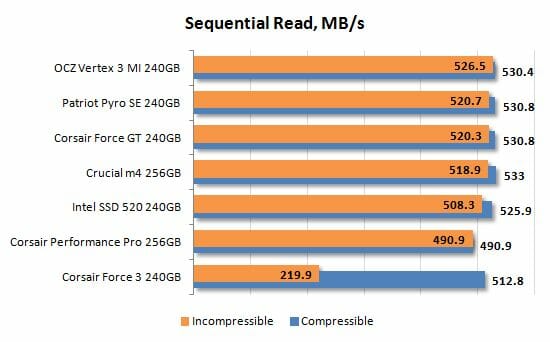
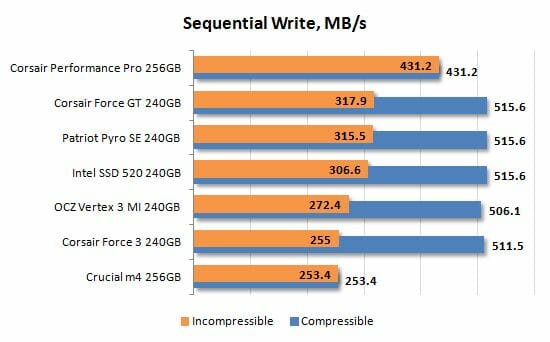
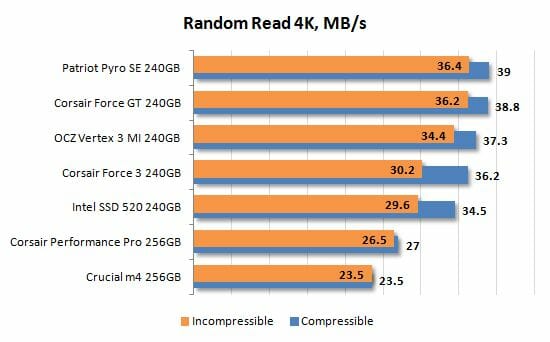
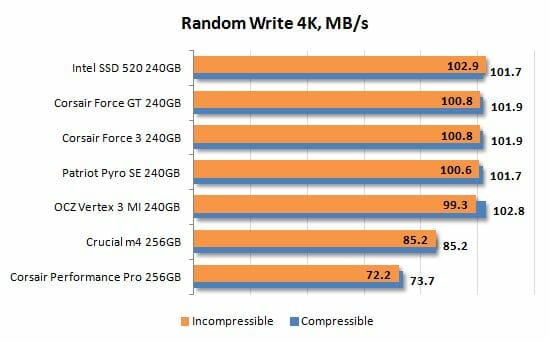
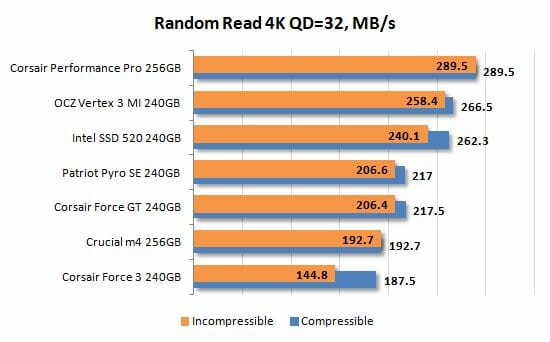
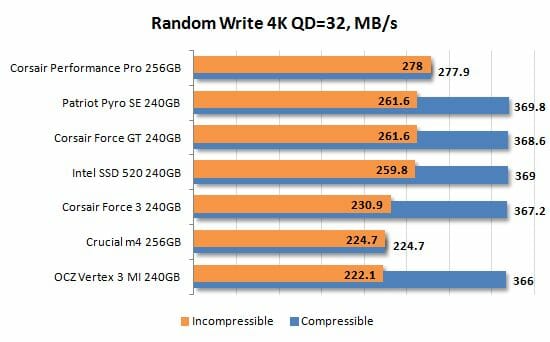
It is not the first time we deal with a drive on SF-2281 controller that is why we were able to predict the results even before the testing. Since Patriot Pyro SE uses synchronous flash memory with ONFI interface, it should work at about the same speed as Corsair Force Series GT, which is exactly what we have just seen. The rule states that the type of flash memory is a major factor affecting performance of an SSD. And there is only one exception to it: Intel SSD 520 Series, which works in its own unique way because of the exclusive firmware.
Degradation and Steady-State Performance
Unfortunately, SSDs are not always as fast as in their “fresh” state. In most cases their performance goes down after some time and in real life we deal with completely different write speeds than what we see on the diagrams in the previous chapter of our review. The reason for this phenomenon is the following: as the SSD runs out of free pages in the flash memory, its controller has to clear memory page blocks before saving data into them, which causes substantial delays. Although, modern SSD controllers can alleviate the performance drop by erasing unused flash memory pages ahead of time, when idle. They use two techniques for that: idle-time garbage collection and TRIM.
Of course, users are more interested in the consistent performance of their SSDs over a long period of time rather than the peak speed they are going to see only during the initial short-term usage period, while the drive is still “fresh”. The SSD makers, however, declare the speed characteristics of “fresh” SSDs for marketing reasons. That’s why we decided to test the performance hit that occurs when a “fresh” SSD becomes a “steady” one.
To get a complete picture of SSD performance degradation we ran special tests based on the SNIA SSSI TWG PTS (Solid State Storage Performance Test Specification) methodology. The main idea of this approach is to measure write speed consecutively in four different cases. First we measure the “fresh” SSD speed. Then we measure the speed after the SSD has been fully filled with data twice. The third test occurs after a 30-minute break during which the controller can partially restore performance by running the idle-time garbage collection. And finally, we measure the speed after issuing a TRIM command.
We ran the tests in synthetic IOMeter 1.1.0 RC1 benchmark, where we measured random write speed when working with 4 KB data blocks aligned to flash memory pages at 32 requests queue depth. The test data were pseudo-random.
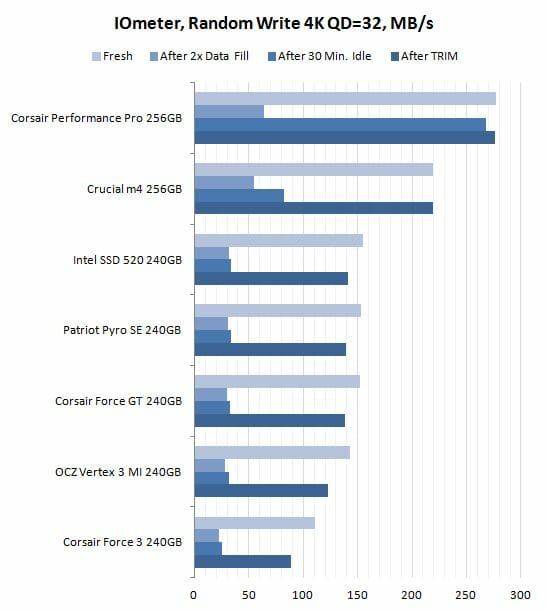
Here Patriot Pyro SE behaves just like all other SandForce based SSDs. Background garbage collection barely works in them and the only way to restore performance is by launching the TRIM. However, even TRIM can’t bring the original performance back: Patriot Pyro SE in steady state will still be slower than the new SSD. However, it only shows in writes. The results of the second round of tests in CrystalDiskMark 3.0.1 are given on the diagram below:
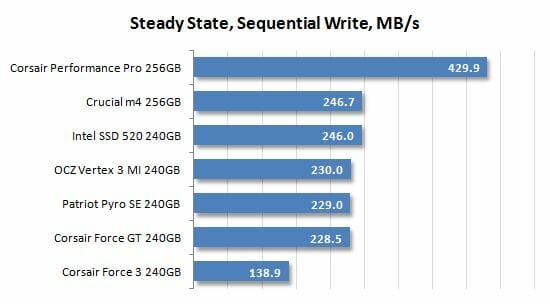
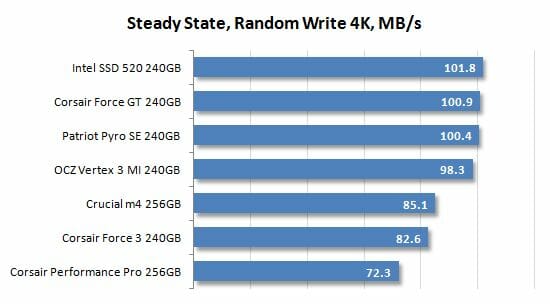
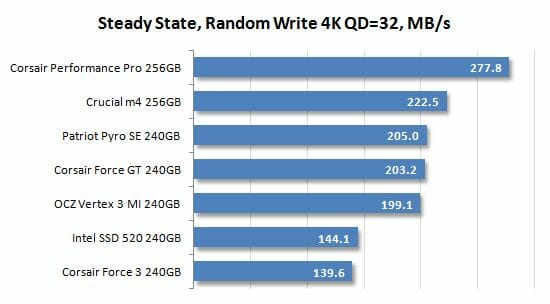
If you prefer solid state drives that won’t lose any of their speed over time, then you should go with the products using Marvell 88SS9174 controller. In fact, this peculiarity makes them demonstrate higher write speeds than the SandForce based drives after they have been completely filled with data. As for the Patriot Pyro SE, this SSD is not any different than the other drives like this. Its results are identical to those of Corsair Force GT in fresh as well as steady state, i.e. it will be identical to all other SandForce based products using synchronous flash memory from Micron or Intel.
Futuremark PCMark 7
The popular PCMark 7 contains an individual disk subsystem benchmark. It is not a synthetic test, but is based on real-life applications. This benchmark reproduces typical disk usage scenarios and measures how fast they are completed in popular applications. Moreover, the disk access commands are not executed as a steady uninterrupted flow, but in a more realistic manner – with certain pauses caused by the need to process the data. The benchmark generates an overall disk subsystem performance rating as well as speed readings in MB/s in individual usage scenarios. Note that the absolute speed in these scenarios is not too high because of the above mentioned pauses between individual input/output operations. In other words, PCMark 7 shows you the speed of the disk subsystem from the application’s point of view. Numbers like that show us not only the pure performance of an SSD, but mostly how big of a performance gain a certain SSD can guarantee in real life.
We ran PCMark 7 on “steady” SSDs, which is what they are going to be in actual computer systems most of the time. Their performance in this case is affected not only by their controller or flash memory speed but also by the efficiency of their internal algorithms that fight performance degradation.
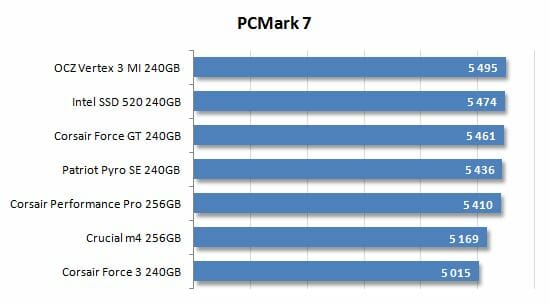
The PCMark 7 score is a good guide for users who want to see how SSDs perform in typical applications without delving into technical details. For some reason Patriot Pyro SE is a little slower than Corsair Force GT here. However, its performance is still much higher than that of SandForce SSDs with asynchronous flash memory or than that of Marvell based products.
Let’s check out the individual tests to get a more detailed picture of what our SSDs are capable of under various types of operational load:
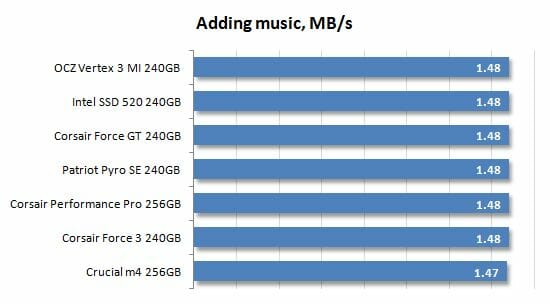
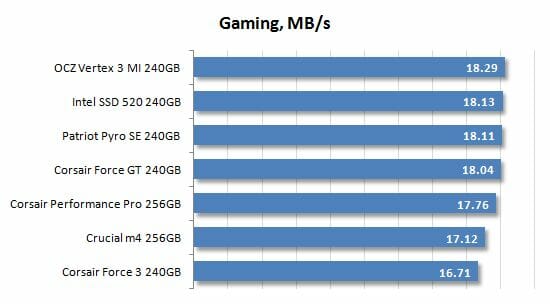
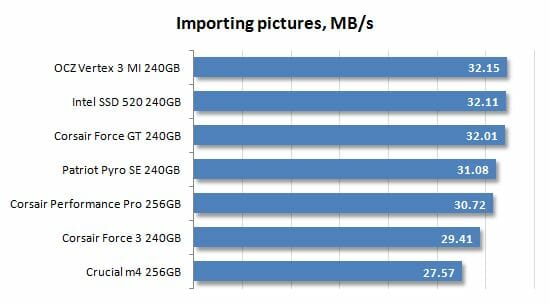
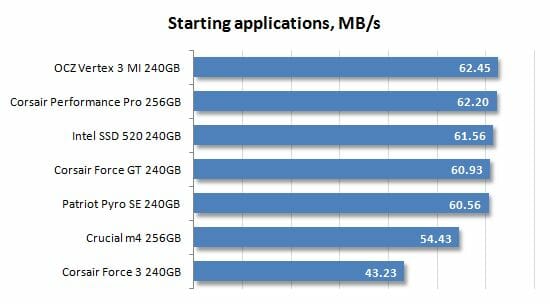
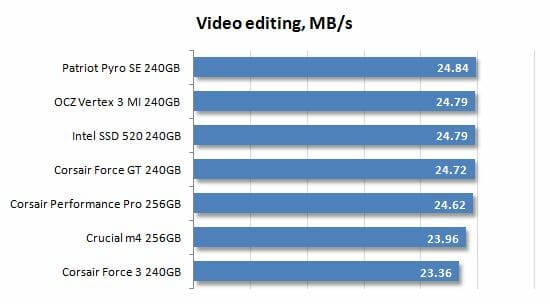
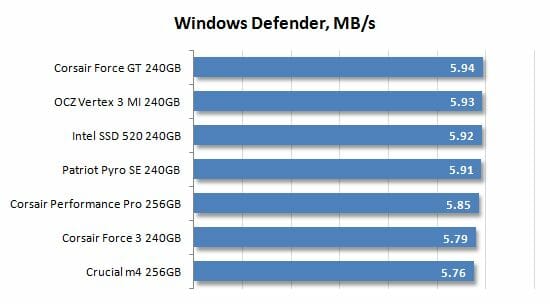
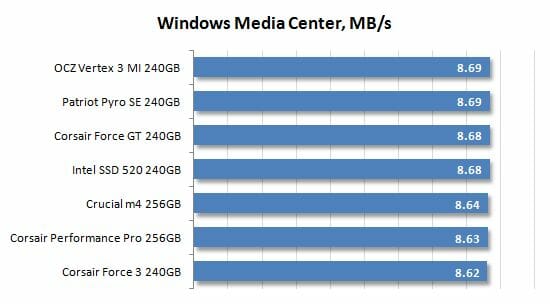
The diagrams show that the total PCMark 7 score of Patriot Pyro SE is lower than that of the Corsair SSD because of the “Importing Pictures” tests, where Patriot SSD experiences some problems.
Intel NAS Performance Toolkit
Intel NASPT is another disk sub-system test that uses real-life usage scenarios. Like PCMark 7, Intel NASPT reproduces predefined disk activity traces and measures how fast they are executed. However, the default traces are designed for network attached storage devices rather than for SSDs. Therefore during our test session we replace them with the specially developed SSD Benchmarking Suite which offers more relevant usage scenarios such as compressing and decompressing files, compiling large projects, copying files and folders, loading 3D game levels, installing software, batch-processing photos, searching a digital library for data, mass-launching applications, and transcoding video.
Like PCMark 7, this benchmark gives us a true-to-life illustration of disk subsystem performance. Here the SSDs are again tested in their “steady” state.
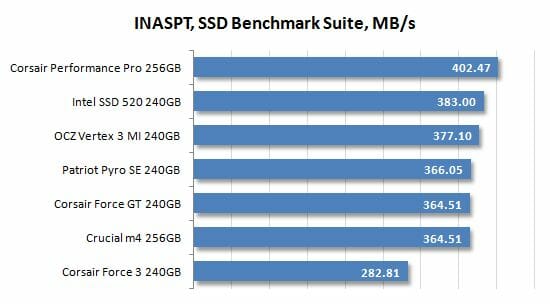
Here Patriot Pyro SE performance is again similar to that of other SF-2281 based SSDs using synchronous flash memory. Our hero outperforms the solutions built with asynchronous flash and runs neck and neck with Crucial m4, though it still falls behind Intel SSD 520, Corsair Performance Pro and OCZ Vertex 3.
The detailed INASPT results help us see what usage scenarios are the most suitable for our today’s testing participants. Take note that the data-transfer rate is higher than the SATA III interface bandwidth in some subtests. That’s because INASPT is a high-level test that uses standard Windows functions to access the disk subsystem. As a result, the OS caching mechanisms also affect the results.
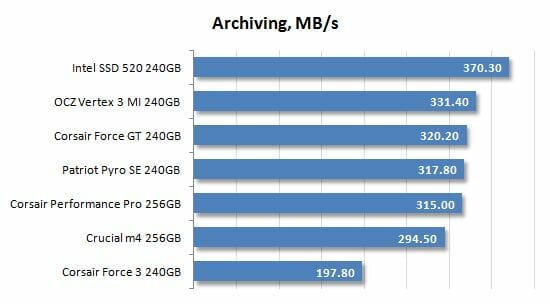
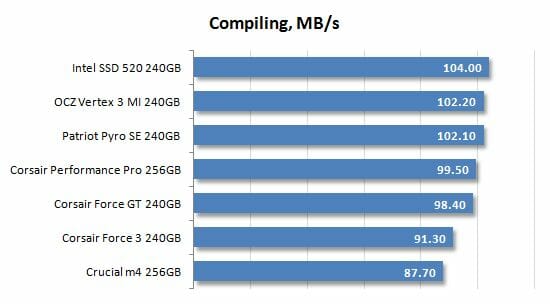
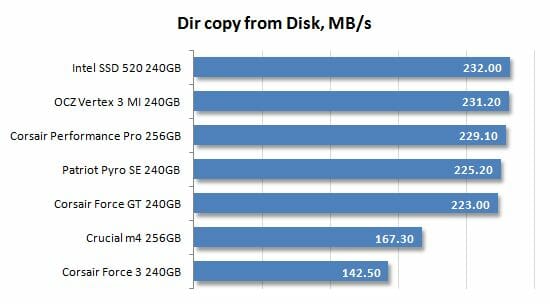
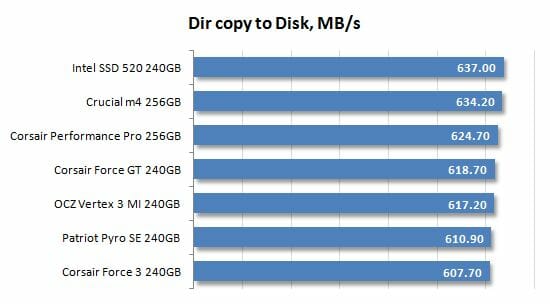
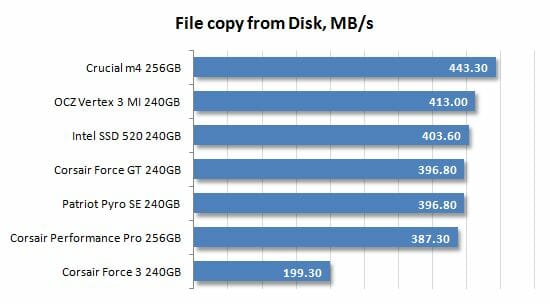
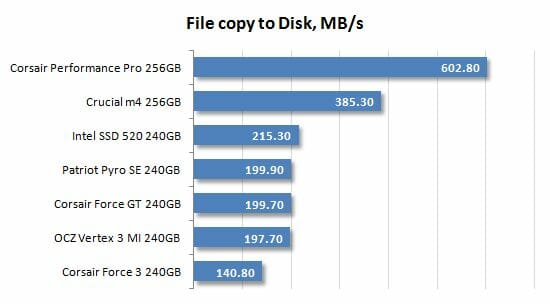
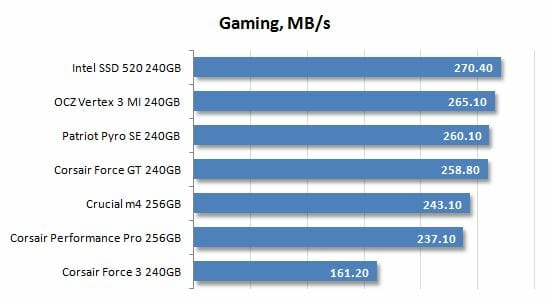
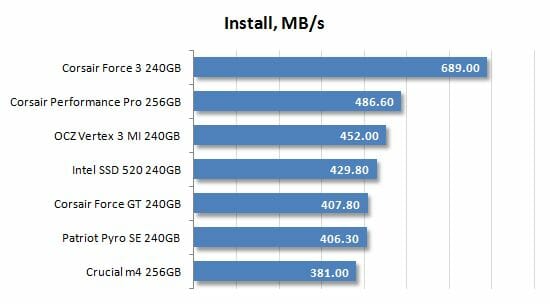
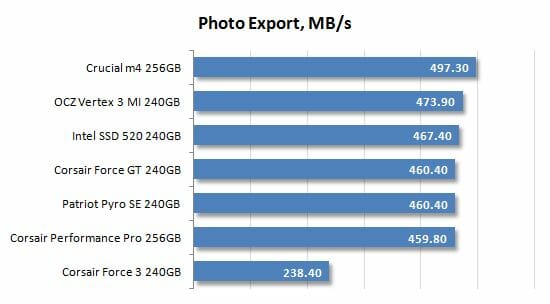
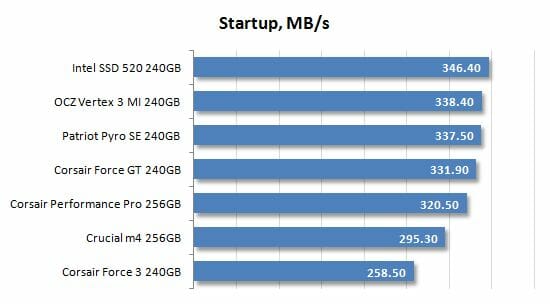
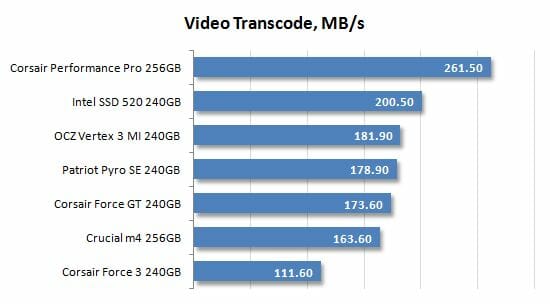
Patriot Pyro SE is not really different from Corsair Force GT in any way. For INASPT it is a totally ordinary SandForce based mainstream solid state drive.
Conclusion
Patriot has slightly delayed the launch of their SandForce SSDF with synchronous ONFI flash memory, but we can’t come up with any objective reasons justifying this delay. Pyro SE, which falls right in the middle between the other two SSD families from Patriot, Wildfire and Pyro, turned out a very standard product built around SF-2281 controller. It doesn’t boast any unique flash memory chips or firmware optimizations. Therefore, the results of our performance tests also turned out quite predictable. We got another implementation of an “SF-2281 + synchronous memory” combination, which offers the same consumer features as other popular SSDs, such as OCZ Vertex 3, Corsair Force GT or Kingston HyperX.
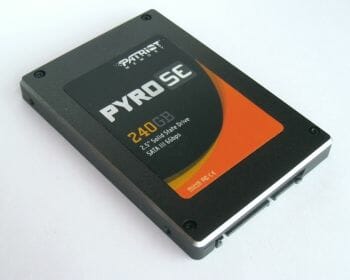
However, it is more of a good thing than a bad one. Patriot Pyro SE won’t catch you unawares, as it features time-tested internal architecture and bug-free firmware. Its performance is at a very good level for contemporary SSDs, and the price is in many cases even more attractive than that of the competitors with popular brand names. In other words, if you are looking for a second-generation SandForce based SSD, then Patriot Pyro SE is a very good candidate. However, do not forget that there is no mounting kit for the 3.5-inch case bay included with the drive, and it is probably its most serious shortcoming.
Summing up everything we know about SandForce based drives, which we have tested in our lab, we continue adding to our “ranking chart”. Here all SSDs are split into groups according to their performance. Our experience suggests that there are four groups like that, which differ dramatically from one another in performance, but the drives within the groups are practically identical.